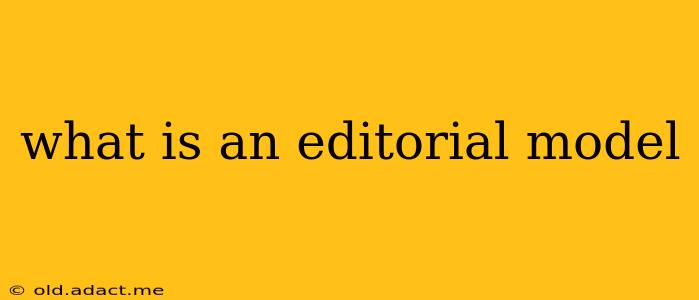An editorial model is the framework that guides how a publication, website, or content creator develops and publishes content. It's more than just a style guide; it's a comprehensive strategy encompassing everything from content pillars and target audience to tone of voice and distribution channels. Think of it as the blueprint for your content creation process, ensuring consistency, quality, and alignment with your overall goals.
This isn't a one-size-fits-all approach. The ideal editorial model varies significantly based on the organization's size, resources, and objectives. A small blog will have a different editorial model than a large news organization or a corporate website. But all successful models share some core components.
Key Components of an Effective Editorial Model
Several crucial elements contribute to a robust editorial model:
-
Target Audience: Who are you trying to reach? Understanding their demographics, interests, needs, and pain points is critical in shaping your content strategy. This informs everything from topic selection to writing style.
-
Content Pillars: These are the core themes or subjects your content revolves around. They provide a structure and focus, ensuring your content remains relevant and cohesive. Think of them as the main branches of your content tree.
-
Content Formats: What types of content will you create? This might include blog posts, articles, videos, infographics, podcasts, social media updates, and more. Diversity is key to engaging a broad audience.
-
Editorial Calendar: A schedule for planning and publishing content. This helps maintain consistency and allows for strategic content releases timed to coincide with relevant events or trends.
-
Content Workflow: This outlines the steps involved in creating and publishing content, from idea generation to editing and distribution. A well-defined workflow ensures efficiency and high-quality output.
-
Style Guide: A set of rules and guidelines for writing, formatting, and visual consistency. This ensures a unified brand voice and enhances readability.
-
Content Promotion Strategy: How will you get your content in front of your target audience? This includes SEO, social media marketing, email marketing, and other distribution channels.
-
Metrics and Analytics: How will you measure the success of your editorial model? Key performance indicators (KPIs) such as website traffic, engagement, and conversions are essential for continuous improvement.
Frequently Asked Questions about Editorial Models
Here are answers to some common questions surrounding editorial models:
What is the difference between an editorial model and a content strategy?
While closely related, there's a subtle difference. Content strategy is the overarching plan defining the goals, audience, and overall approach to content creation. The editorial model is the how—the specific processes, guidelines, and workflows used to implement that strategy. The content strategy sets the destination; the editorial model is the roadmap.
How do I choose the right editorial model for my business?
The ideal model depends on your specific needs and resources. Consider factors like:
- Your business goals: What do you hope to achieve with your content? (Brand awareness, lead generation, sales, etc.)
- Your target audience: Who are you trying to reach?
- Your budget and resources: How much time and money can you dedicate to content creation?
- Your team's capabilities: What skills and expertise do you have in-house?
How often should I review and update my editorial model?
Regular review is crucial. The digital landscape is constantly evolving, so your editorial model should adapt accordingly. At minimum, review and update it annually, or more frequently if significant changes occur in your business or target audience.
What are some examples of different editorial models?
Several models exist, ranging from highly structured and centralized approaches to more decentralized and agile ones. Examples include:
- Hub and Spoke Model: Focuses on a central topic (hub) with related content (spokes) branching out.
- Pillar-Based Model: Organizes content around core themes or pillars.
- Agile Editorial Model: Emphasizes flexibility and iterative improvements.
Choosing the right editorial model is crucial for content success. By carefully considering your goals, audience, and resources, you can create a framework that guides your content creation and drives results. Remember that continuous evaluation and adaptation are key to staying relevant and effective in the ever-changing digital world.
